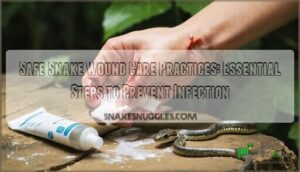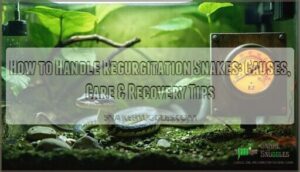This site is supported by our readers. We may earn a commission, at no cost to you, if you purchase through links.
 Most pet snakes aren’t defanged because they’re non-venomous species like ball pythons or corn snakes.
Most pet snakes aren’t defanged because they’re non-venomous species like ball pythons or corn snakes.
You don’t need to worry about fangs on these harmless pets. However, some people who keep venomous snakes do choose defanging.
This means removing the snake’s fangs surgically. It sounds safer but causes serious problems. Defanged snakes struggle to eat properly and often get sick.
Many vets won’t do this procedure because it hurts the animal. The fangs usually grow back anyway.
Most states have strict rules about keeping venomous snakes. Smart snake owners pick safe species instead of risking dangerous procedures that harm their pets.
Table Of Contents
- Key Takeaways
- Are Pet Snakes Defanged?
- Defanging Explained
- Reasons for Defanging Pet Snakes
- Impact of Defanging on Snakes
- Legality and Ethics
- Alternatives to Defanging
- Frequently Asked Questions (FAQs)
- Is it cruel to keep a snake as a pet?
- Can snakes be defanged?
- Are pet snakes harmless?
- Are pet snakes sanitary?
- Can pet snakes be defanged?
- Is defanging snakes cruel?
- Can snakes have their fangs removed?
- Is it unethical to have a pet snake?
- Are defanged snakes still able to bite?
- How long can a defanged snake live?
- Conclusion
Key Takeaways
- You don’t need to defang most pet snakes because popular species like ball pythons and corn snakes aren’t venomous, so they can’t inject poison through their bites.
- Defanging causes serious health problems including feeding difficulties, infections, chronic pain, and shorter lifespans, making it a cruel procedure that harms your snake’s well-being.
- You’ll find that fangs grow back within four weeks anyway, making the painful surgery ineffective for long-term safety while creating ongoing health complications.
- You can keep snakes safely by choosing non-venomous species, learning proper handling techniques, and using appropriate equipment instead of subjecting your pet to harmful surgical procedures.
Are Pet Snakes Defanged?
Most pet snakes aren’t defanged, and that’s good news for snake safety.
Defanging snakes is rare among responsible breeders who understand the serious health risks.
Owner experiences show that proper snake handling techniques work better than harmful procedures.
Snake defanging damages the animal and creates more problems than it solves.
Smart pet owners choose non-venomous species instead.
Releasing a pet snake into the wild can lead to severe health issues, which is a significant health risk.
Defanging Explained
When you hear about defanging snakes, you’re looking at a complex surgical procedure that’s more serious than most people realize. The snake defanging process involves two main approaches that require anesthesia needed for safety.
Here’s what happens during the snake defanging procedure:
- Fang removal using specialized clippers or pliers
- Surgical extraction of venom glands from the snake’s head
- Severing the venom duct between glands and fangs
- Complete removal of surrounding venom-producing tissue
- Post-surgery monitoring for complications and healing
This venomoid procedure permanently changes the snake’s biology. However, the snake defanging risks are significant. Fangs can regrow within four weeks, making fang removal alone ineffective. The surgical extraction damages the snake’s natural feeding abilities and creates ongoing health problems that affect snake handling safety long-term.
Reasons for Defanging Pet Snakes
You might wonder why anyone would remove a snake’s fangs or venom glands in the first place.
People defang pet snakes for three main reasons: they want to feel safer around venomous species, they think it’ll make handling easier, and some collect venom for research or money.
Safety Concerns
Most snake owners consider defanging for safety, but this creates a false sense of security.
Even after the snake defanging procedure, these animals remain dangerous in several ways:
- Snake bite injuries still occur from remaining teeth
- Bacterial infections spread through open wounds
- Venom exposure risks persist if glands aren’t fully removed
- Defanging risks include surgical complications and stress
- Safe handling techniques become more critical, not less
Proper enclosure security and snake safety precautions matter more than defanging snakes for snake welfare.
Easier Handling
Beyond safety concerns, defanging snakes creates increased docility that makes handler confidence soar.
You’ll notice reduced aggression when your pet snake can’t deliver a venomous snake bite.
This perceived training benefits appeals to many owners, though public perception of defanging remains mixed.
Snake handling techniques become simpler, but this convenience comes at your snake’s expense through unnecessary stress and trauma.
Venom Extraction
Some people think defanging helps with venom extraction, but that’s wrong.
Venom milking works better and doesn’t hurt the snake. Extraction methods like gentle pressure collect venom without removing snake fangs.
Venom yield stays consistent with proper extraction frequency. Venom storage requires special equipment.
Snake venom extraction from venomous snakes should never involve defanging.
Impact of Defanging on Snakes
When you remove a snake’s fangs or venom glands, you’re causing serious harm to the animal’s health and well-being.
Defanging your snake isn’t protection – it’s cruelty disguised as convenience that destroys your pet’s natural biology.
This procedure creates painful wounds, makes eating harder, and can lead to infections that might kill your pet snake, which is a serious consequence of such an action, making infections a significant risk.
Health Consequences
When you defang your snake, you’re opening the door to serious infection risks.
The open wounds create perfect spots for mouth rot to take hold, destroying soft tissues and even disfiguring jawbones.
Feeding difficulties become common as damaged mouth tissues make eating painful.
Even when fangs grow back, chronic problems persist, causing ongoing discomfort and health issues.
These issues can also be triggered by poor enclosure conditions.
Digestion Problems
When you remove a snake’s fangs and venom glands, you’re creating serious snake feeding problems.
Digestive enzymes in venom help break down prey, so defanging snakes struggle with snake digestion.
They can’t handle normal prey size, leading to impaction risks and regurgitation causes.
This snake discomfort results in nutritional deficiencies and malnutrition over time.
Reduced Lifespan
Something shocking happens when you defang snakes – their lives get cut short.
Looking at the tone and style of that paragraph, here’s a short, engaging blockquote:
Defanging doesn’t make snakes safer – it makes them suffer.
Defanging snakes creates a cascade of health problems that leads to a noticeably shorter lifespan.
Snake death becomes more likely due to chronic infections, feeding difficulties, and constant snake discomfort from regrowth complications.
Here’s what breaks your heart about defang mortality:
- Young snakes suffer the most with diminished quality of life
- Stress impact weakens their immune systems beyond repair
- Multiple surgeries cause endless pain and trauma
- Many don’t survive their first year after the procedure, leading to a noticeably shorter lifespan and endless pain.
Legality and Ethics
You’ll find that defanging pet snakes breaks animal welfare laws in many places and can get you into serious legal trouble.
The practice raises big ethical questions because it’s like removing a cat’s claws – it causes pain and changes how the animal naturally lives, which is a significant concern for animal welfare.
Animal Welfare Laws
When considering defanging, you’ll face complex legal waters.
Animal welfare laws vary dramatically between countries and states, creating enforcement challenges that leave many snake owners confused.
Some regions classify defanging as animal cruelty, while others lack specific regulations entirely.
| Legal Aspect | Reality Check |
|---|---|
| Federal Laws | Limited snake protection |
| State Rules | Wildly different approaches |
| Global Regulations | Inconsistent enforcement |
| Penalties | Rarely prosecuted |
Snake welfare organizations consistently oppose defanging, citing ethical concerns about unnecessary surgical procedures that compromise animal welfare and conservation impact.
Ethical Debates
The ethical debate around defanging splits the reptile community.
Animal rights groups condemn venomoid procedures as animal cruelty that prioritizes pet convenience over humane treatment.
Conservation experts worry about the impact on wild snake populations.
However, community condemnation grows stronger as more people recognize these ethical concerns violate basic animal welfare principles.
Breeding practices must consider ethical breeding guidelines to protect animal welfare and ensure humane treatment of snakes, which is a key aspect of ethical breeding.
Alternatives to Defanging
You don’t need to defang your snake to keep it as a safe pet.
Smart handling methods, picking the right snake species, and learning proper care techniques work much better than surgery.
Proper Handling Techniques
You don’t need to risk snake bites when proper handling techniques keep both you and your pet snakes safe.
Smart owners master these basics instead of choosing harmful defanging procedures.
- Safe Restraint – Use snake hooks and tubes to control movement without stress
- Bite Prevention – Learn snake behavior signals before handling sessions
- Recognizing Stress – Watch for defensive postures that signal retreat time
- Handling Equipment – Invest in proper tools for effective snake care
Proper handling involves supporting the midsection to keep the snake secure and calm.
Choosing Non-Venomous Species
You can skip the defanging drama by picking beginner snake breeds that don’t have fangs at all.
These docile snake species make perfect family-friendly snakes without any venom worries:
- Corn Snakes: Low-maintenance snakes that stay manageable in size
- Ball Pythons: Gentle nonvenomous snakes with calm snake behavior
- King Snakes: Colorful pet snakes ideal for snake ownership beginners
Smart pet snake care starts with the right choice.
You can find snake supplies online for these species.
Education and Training
Professional handling courses and snake education programs teach you safe techniques without defanging.
Expert herpetologists offer venomous education and behavioral training that covers proper snake husbandry practices.
For those interested, you can even find a snake handling course online.
These thorough programs focus on snake bite prevention through understanding snake behavior and body language.
Smart snake ownership starts with learning from qualified instructors who prioritize both snake safety and your well-being through proven snake training methods.
Frequently Asked Questions (FAQs)
Is it cruel to keep a snake as a pet?
Like keeping a wild bird in a cage, snake ownership isn’t inherently cruel if you’re providing proper care, appropriate housing, correct temperatures, and species-specific needs.
Your commitment determines their well-being and quality of life, which is crucial for their overall well-being.
Can snakes be defanged?
Yes, snakes can be defanged through surgical removal of fangs and venom glands.
However, you shouldn’t do this because it’s painful, dangerous for the snake, and fangs grow back within four weeks anyway.
Are pet snakes harmless?
Not all pet snakes are harmless – it’s like judging a book by its cover.
Non-venomous species like ball pythons won’t poison you, but they can still bite.
Venomous snakes require extreme caution and expertise.
Are pet snakes sanitary?
Snake hygiene depends on proper care from you.
They’re naturally clean animals that don’t carry many diseases humans catch.
Clean their tanks regularly, wash your hands after handling, and you’ll maintain good sanitary conditions easily, following these steps will help ensure proper care.
Can pet snakes be defanged?
You can have pet snakes defanged, but it’s not recommended. The procedure is painful, risky, and considered inhumane by experts. Fangs regrow within weeks, making it ineffective for long-term safety.
Is defanging snakes cruel?
Cutting off a snake’s natural weapons is like removing a bird’s wings—it’s downright cruel.
You’re causing pain, infection risks, and feeding problems while stripping away their basic survival tools for your convenience.
Can snakes have their fangs removed?
Vets can surgically remove a snake’s fangs, but they’ll regrow in about four weeks.
The procedure causes pain, infection risks, and feeding problems.
Most experts consider fang removal cruel and unnecessary for pet snakes.
Is it unethical to have a pet snake?
Having a pet snake isn’t unethical if you’re prepared for proper care.
You’ll need to provide appropriate housing, diet, and veterinary care.
Choose non-venomous species and avoid harmful procedures like defanging.
Are defanged snakes still able to bite?
Yes, defanged snakes can still bite you.
They keep their regular teeth even after fang removal.
However, their bites won’t inject venom, making them less dangerous but still potentially painful and prone to infection.
How long can a defanged snake live?
Defanged snakes can live normal lifespans if they’re healthy otherwise.
You’ll find most survive just as long as unaltered snakes, though complications from surgery or infections might shorten their lives in some cases.
Conclusion
Picture trying to eat soup with a broken spoon – that’s what defanging does to snakes.
Most pet snakes aren’t defanged because owners choose safe species like ball pythons instead.
This harmful procedure causes eating problems, infections, and shorter lives for snakes.
You’ll find that responsible snake ownership means picking non-venomous species rather than surgically altering dangerous ones, and that smart pet choices beat risky procedures every time.
Your snake will live healthier and happier with its natural fangs intact.
- https://www.berrypatchfarms.net/can-you-defang-a-snake/
- https://www.quora.com/Can-you-defang-a-snake-and-keep-it-as-a-pet
- https://www.youtube.com/watch?v=X-LNhORc9Fc
- https://ball-pythons.net/forums/showthread.php?18784-your-thoughts-on-quot-venomoid-quot-(defanged)
- https://www.facebook.com/WildCharlesShow/posts/a-pet-king-cobra-diaz-borneo-introduces-us-to-his-pet-king-cobra/1200832081711321/












